Massage Therapy Intervention - PDF
VerifiedAdded on 2021/05/31
|14
|3631
|30
AI Summary
Contribute Materials
Your contribution can guide someone’s learning journey. Share your
documents today.
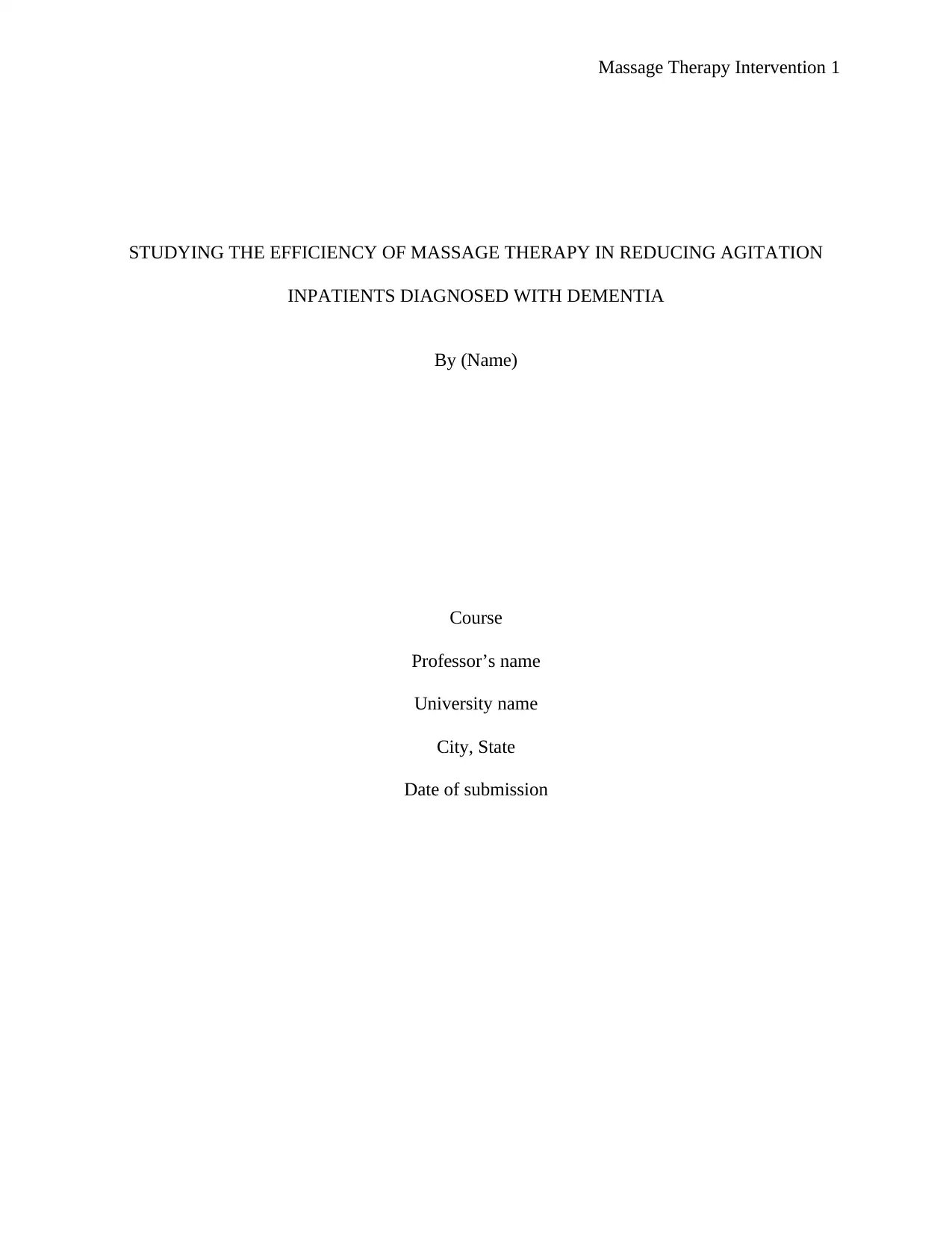
Massage Therapy Intervention 1
STUDYING THE EFFICIENCY OF MASSAGE THERAPY IN REDUCING AGITATION
INPATIENTS DIAGNOSED WITH DEMENTIA
By (Name)
Course
Professor’s name
University name
City, State
Date of submission
STUDYING THE EFFICIENCY OF MASSAGE THERAPY IN REDUCING AGITATION
INPATIENTS DIAGNOSED WITH DEMENTIA
By (Name)
Course
Professor’s name
University name
City, State
Date of submission
Secure Best Marks with AI Grader
Need help grading? Try our AI Grader for instant feedback on your assignments.
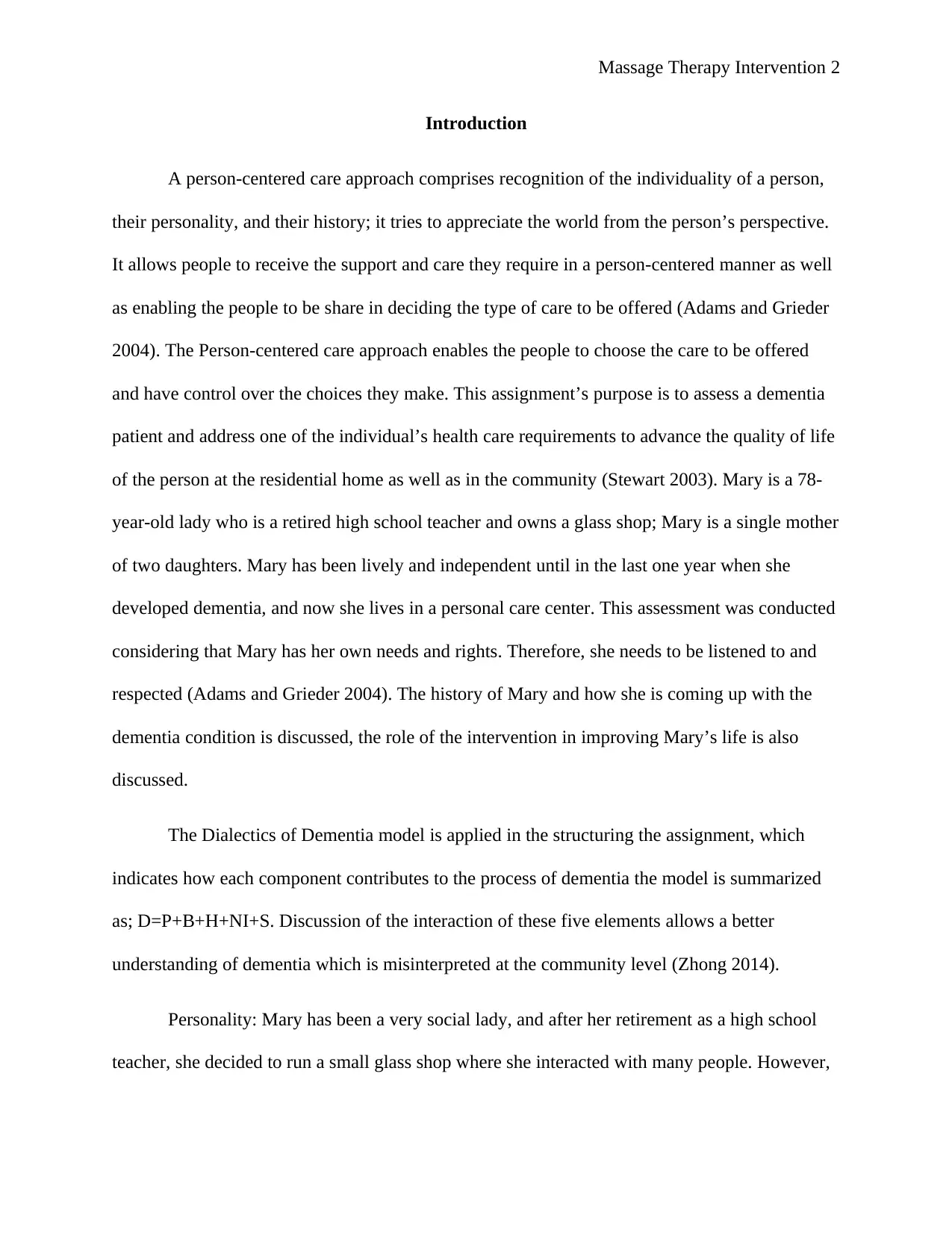
Massage Therapy Intervention 2
Introduction
A person-centered care approach comprises recognition of the individuality of a person,
their personality, and their history; it tries to appreciate the world from the person’s perspective.
It allows people to receive the support and care they require in a person-centered manner as well
as enabling the people to be share in deciding the type of care to be offered (Adams and Grieder
2004). The Person-centered care approach enables the people to choose the care to be offered
and have control over the choices they make. This assignment’s purpose is to assess a dementia
patient and address one of the individual’s health care requirements to advance the quality of life
of the person at the residential home as well as in the community (Stewart 2003). Mary is a 78-
year-old lady who is a retired high school teacher and owns a glass shop; Mary is a single mother
of two daughters. Mary has been lively and independent until in the last one year when she
developed dementia, and now she lives in a personal care center. This assessment was conducted
considering that Mary has her own needs and rights. Therefore, she needs to be listened to and
respected (Adams and Grieder 2004). The history of Mary and how she is coming up with the
dementia condition is discussed, the role of the intervention in improving Mary’s life is also
discussed.
The Dialectics of Dementia model is applied in the structuring the assignment, which
indicates how each component contributes to the process of dementia the model is summarized
as; D=P+B+H+NI+S. Discussion of the interaction of these five elements allows a better
understanding of dementia which is misinterpreted at the community level (Zhong 2014).
Personality: Mary has been a very social lady, and after her retirement as a high school
teacher, she decided to run a small glass shop where she interacted with many people. However,
Introduction
A person-centered care approach comprises recognition of the individuality of a person,
their personality, and their history; it tries to appreciate the world from the person’s perspective.
It allows people to receive the support and care they require in a person-centered manner as well
as enabling the people to be share in deciding the type of care to be offered (Adams and Grieder
2004). The Person-centered care approach enables the people to choose the care to be offered
and have control over the choices they make. This assignment’s purpose is to assess a dementia
patient and address one of the individual’s health care requirements to advance the quality of life
of the person at the residential home as well as in the community (Stewart 2003). Mary is a 78-
year-old lady who is a retired high school teacher and owns a glass shop; Mary is a single mother
of two daughters. Mary has been lively and independent until in the last one year when she
developed dementia, and now she lives in a personal care center. This assessment was conducted
considering that Mary has her own needs and rights. Therefore, she needs to be listened to and
respected (Adams and Grieder 2004). The history of Mary and how she is coming up with the
dementia condition is discussed, the role of the intervention in improving Mary’s life is also
discussed.
The Dialectics of Dementia model is applied in the structuring the assignment, which
indicates how each component contributes to the process of dementia the model is summarized
as; D=P+B+H+NI+S. Discussion of the interaction of these five elements allows a better
understanding of dementia which is misinterpreted at the community level (Zhong 2014).
Personality: Mary has been a very social lady, and after her retirement as a high school
teacher, she decided to run a small glass shop where she interacted with many people. However,
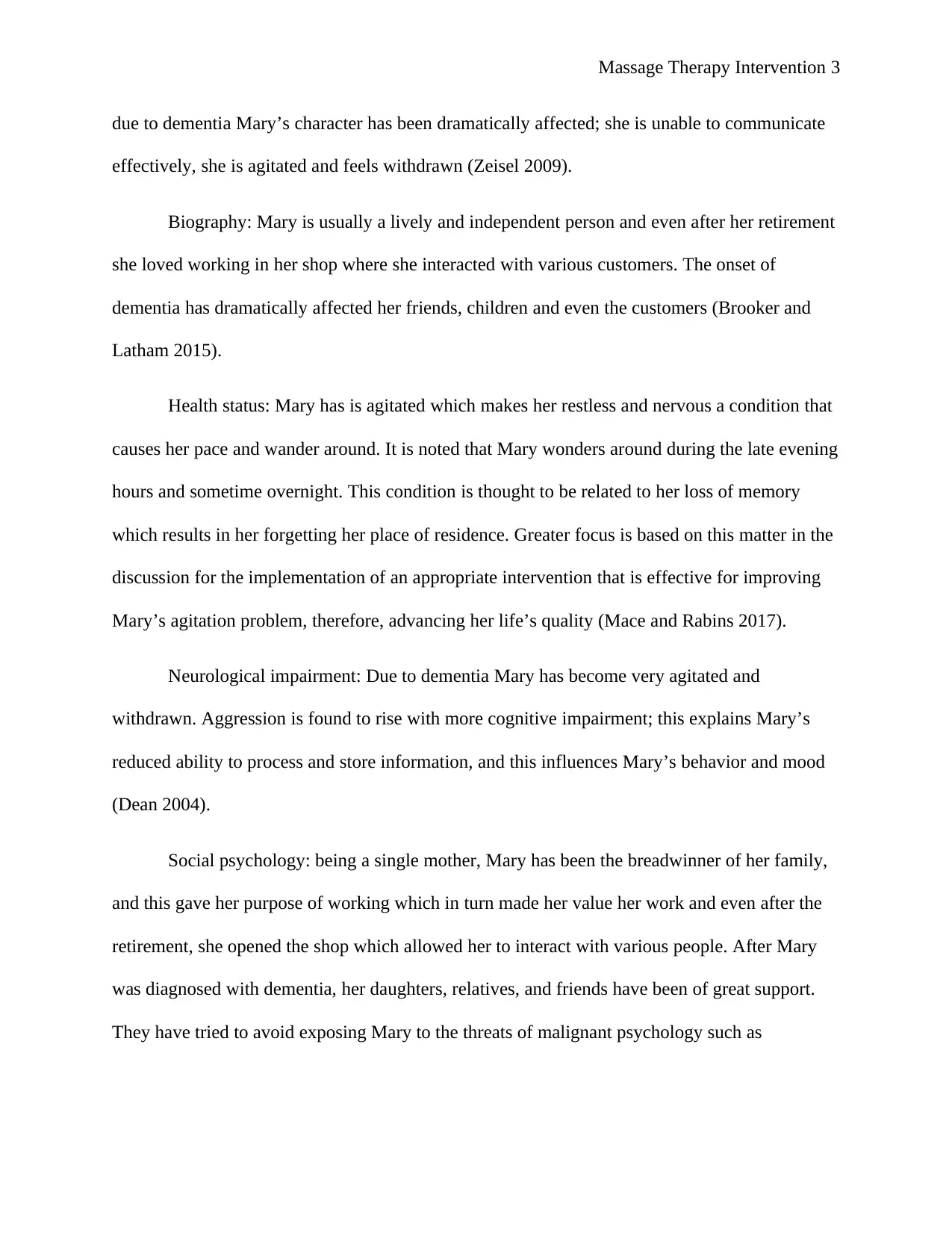
Massage Therapy Intervention 3
due to dementia Mary’s character has been dramatically affected; she is unable to communicate
effectively, she is agitated and feels withdrawn (Zeisel 2009).
Biography: Mary is usually a lively and independent person and even after her retirement
she loved working in her shop where she interacted with various customers. The onset of
dementia has dramatically affected her friends, children and even the customers (Brooker and
Latham 2015).
Health status: Mary has is agitated which makes her restless and nervous a condition that
causes her pace and wander around. It is noted that Mary wonders around during the late evening
hours and sometime overnight. This condition is thought to be related to her loss of memory
which results in her forgetting her place of residence. Greater focus is based on this matter in the
discussion for the implementation of an appropriate intervention that is effective for improving
Mary’s agitation problem, therefore, advancing her life’s quality (Mace and Rabins 2017).
Neurological impairment: Due to dementia Mary has become very agitated and
withdrawn. Aggression is found to rise with more cognitive impairment; this explains Mary’s
reduced ability to process and store information, and this influences Mary’s behavior and mood
(Dean 2004).
Social psychology: being a single mother, Mary has been the breadwinner of her family,
and this gave her purpose of working which in turn made her value her work and even after the
retirement, she opened the shop which allowed her to interact with various people. After Mary
was diagnosed with dementia, her daughters, relatives, and friends have been of great support.
They have tried to avoid exposing Mary to the threats of malignant psychology such as
due to dementia Mary’s character has been dramatically affected; she is unable to communicate
effectively, she is agitated and feels withdrawn (Zeisel 2009).
Biography: Mary is usually a lively and independent person and even after her retirement
she loved working in her shop where she interacted with various customers. The onset of
dementia has dramatically affected her friends, children and even the customers (Brooker and
Latham 2015).
Health status: Mary has is agitated which makes her restless and nervous a condition that
causes her pace and wander around. It is noted that Mary wonders around during the late evening
hours and sometime overnight. This condition is thought to be related to her loss of memory
which results in her forgetting her place of residence. Greater focus is based on this matter in the
discussion for the implementation of an appropriate intervention that is effective for improving
Mary’s agitation problem, therefore, advancing her life’s quality (Mace and Rabins 2017).
Neurological impairment: Due to dementia Mary has become very agitated and
withdrawn. Aggression is found to rise with more cognitive impairment; this explains Mary’s
reduced ability to process and store information, and this influences Mary’s behavior and mood
(Dean 2004).
Social psychology: being a single mother, Mary has been the breadwinner of her family,
and this gave her purpose of working which in turn made her value her work and even after the
retirement, she opened the shop which allowed her to interact with various people. After Mary
was diagnosed with dementia, her daughters, relatives, and friends have been of great support.
They have tried to avoid exposing Mary to the threats of malignant psychology such as
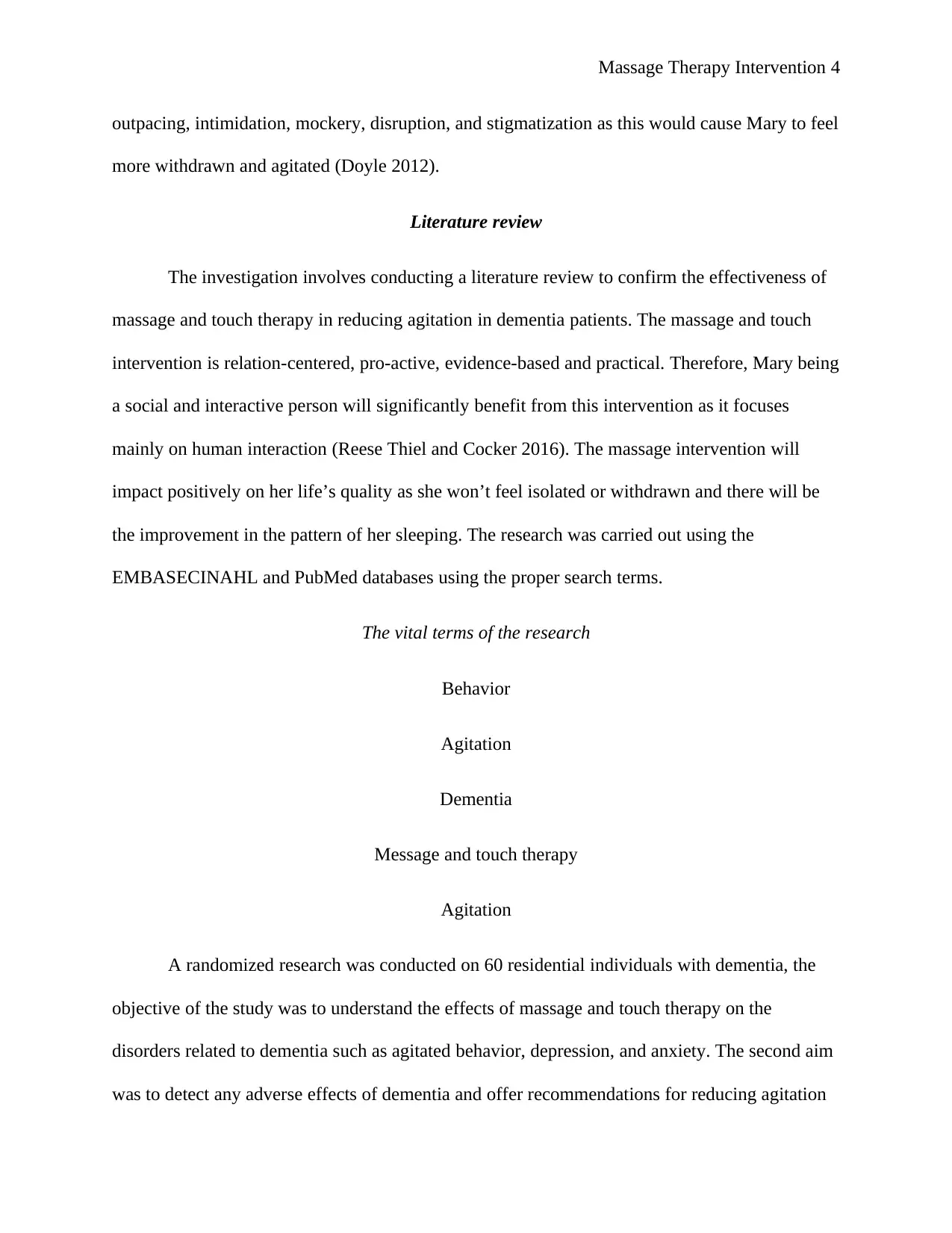
Massage Therapy Intervention 4
outpacing, intimidation, mockery, disruption, and stigmatization as this would cause Mary to feel
more withdrawn and agitated (Doyle 2012).
Literature review
The investigation involves conducting a literature review to confirm the effectiveness of
massage and touch therapy in reducing agitation in dementia patients. The massage and touch
intervention is relation-centered, pro-active, evidence-based and practical. Therefore, Mary being
a social and interactive person will significantly benefit from this intervention as it focuses
mainly on human interaction (Reese Thiel and Cocker 2016). The massage intervention will
impact positively on her life’s quality as she won’t feel isolated or withdrawn and there will be
the improvement in the pattern of her sleeping. The research was carried out using the
EMBASECINAHL and PubMed databases using the proper search terms.
The vital terms of the research
Behavior
Agitation
Dementia
Message and touch therapy
Agitation
A randomized research was conducted on 60 residential individuals with dementia, the
objective of the study was to understand the effects of massage and touch therapy on the
disorders related to dementia such as agitated behavior, depression, and anxiety. The second aim
was to detect any adverse effects of dementia and offer recommendations for reducing agitation
outpacing, intimidation, mockery, disruption, and stigmatization as this would cause Mary to feel
more withdrawn and agitated (Doyle 2012).
Literature review
The investigation involves conducting a literature review to confirm the effectiveness of
massage and touch therapy in reducing agitation in dementia patients. The massage and touch
intervention is relation-centered, pro-active, evidence-based and practical. Therefore, Mary being
a social and interactive person will significantly benefit from this intervention as it focuses
mainly on human interaction (Reese Thiel and Cocker 2016). The massage intervention will
impact positively on her life’s quality as she won’t feel isolated or withdrawn and there will be
the improvement in the pattern of her sleeping. The research was carried out using the
EMBASECINAHL and PubMed databases using the proper search terms.
The vital terms of the research
Behavior
Agitation
Dementia
Message and touch therapy
Agitation
A randomized research was conducted on 60 residential individuals with dementia, the
objective of the study was to understand the effects of massage and touch therapy on the
disorders related to dementia such as agitated behavior, depression, and anxiety. The second aim
was to detect any adverse effects of dementia and offer recommendations for reducing agitation
Secure Best Marks with AI Grader
Need help grading? Try our AI Grader for instant feedback on your assignments.
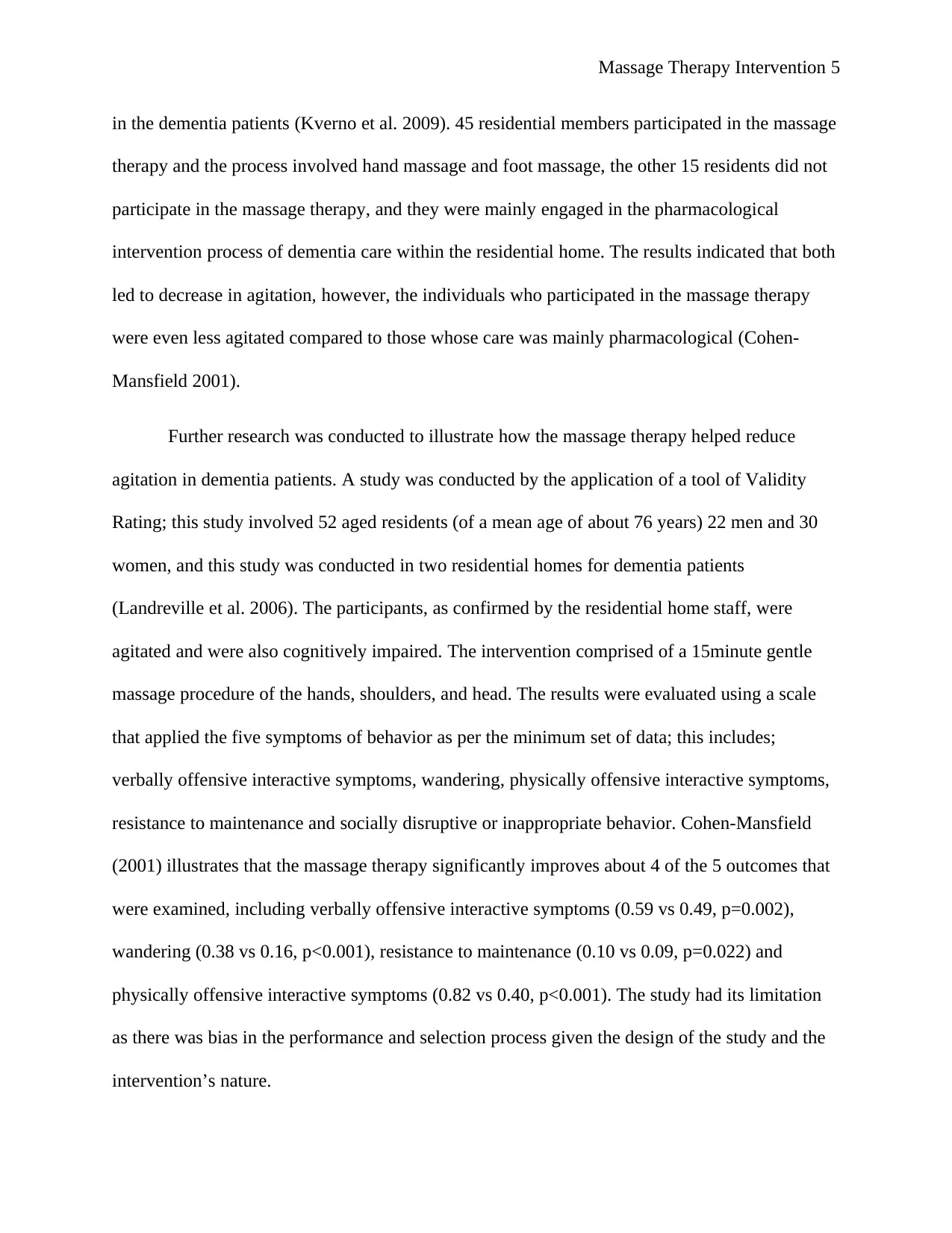
Massage Therapy Intervention 5
in the dementia patients (Kverno et al. 2009). 45 residential members participated in the massage
therapy and the process involved hand massage and foot massage, the other 15 residents did not
participate in the massage therapy, and they were mainly engaged in the pharmacological
intervention process of dementia care within the residential home. The results indicated that both
led to decrease in agitation, however, the individuals who participated in the massage therapy
were even less agitated compared to those whose care was mainly pharmacological (Cohen-
Mansfield 2001).
Further research was conducted to illustrate how the massage therapy helped reduce
agitation in dementia patients. A study was conducted by the application of a tool of Validity
Rating; this study involved 52 aged residents (of a mean age of about 76 years) 22 men and 30
women, and this study was conducted in two residential homes for dementia patients
(Landreville et al. 2006). The participants, as confirmed by the residential home staff, were
agitated and were also cognitively impaired. The intervention comprised of a 15minute gentle
massage procedure of the hands, shoulders, and head. The results were evaluated using a scale
that applied the five symptoms of behavior as per the minimum set of data; this includes;
verbally offensive interactive symptoms, wandering, physically offensive interactive symptoms,
resistance to maintenance and socially disruptive or inappropriate behavior. Cohen-Mansfield
(2001) illustrates that the massage therapy significantly improves about 4 of the 5 outcomes that
were examined, including verbally offensive interactive symptoms (0.59 vs 0.49, p=0.002),
wandering (0.38 vs 0.16, p<0.001), resistance to maintenance (0.10 vs 0.09, p=0.022) and
physically offensive interactive symptoms (0.82 vs 0.40, p<0.001). The study had its limitation
as there was bias in the performance and selection process given the design of the study and the
intervention’s nature.
in the dementia patients (Kverno et al. 2009). 45 residential members participated in the massage
therapy and the process involved hand massage and foot massage, the other 15 residents did not
participate in the massage therapy, and they were mainly engaged in the pharmacological
intervention process of dementia care within the residential home. The results indicated that both
led to decrease in agitation, however, the individuals who participated in the massage therapy
were even less agitated compared to those whose care was mainly pharmacological (Cohen-
Mansfield 2001).
Further research was conducted to illustrate how the massage therapy helped reduce
agitation in dementia patients. A study was conducted by the application of a tool of Validity
Rating; this study involved 52 aged residents (of a mean age of about 76 years) 22 men and 30
women, and this study was conducted in two residential homes for dementia patients
(Landreville et al. 2006). The participants, as confirmed by the residential home staff, were
agitated and were also cognitively impaired. The intervention comprised of a 15minute gentle
massage procedure of the hands, shoulders, and head. The results were evaluated using a scale
that applied the five symptoms of behavior as per the minimum set of data; this includes;
verbally offensive interactive symptoms, wandering, physically offensive interactive symptoms,
resistance to maintenance and socially disruptive or inappropriate behavior. Cohen-Mansfield
(2001) illustrates that the massage therapy significantly improves about 4 of the 5 outcomes that
were examined, including verbally offensive interactive symptoms (0.59 vs 0.49, p=0.002),
wandering (0.38 vs 0.16, p<0.001), resistance to maintenance (0.10 vs 0.09, p=0.022) and
physically offensive interactive symptoms (0.82 vs 0.40, p<0.001). The study had its limitation
as there was bias in the performance and selection process given the design of the study and the
intervention’s nature.
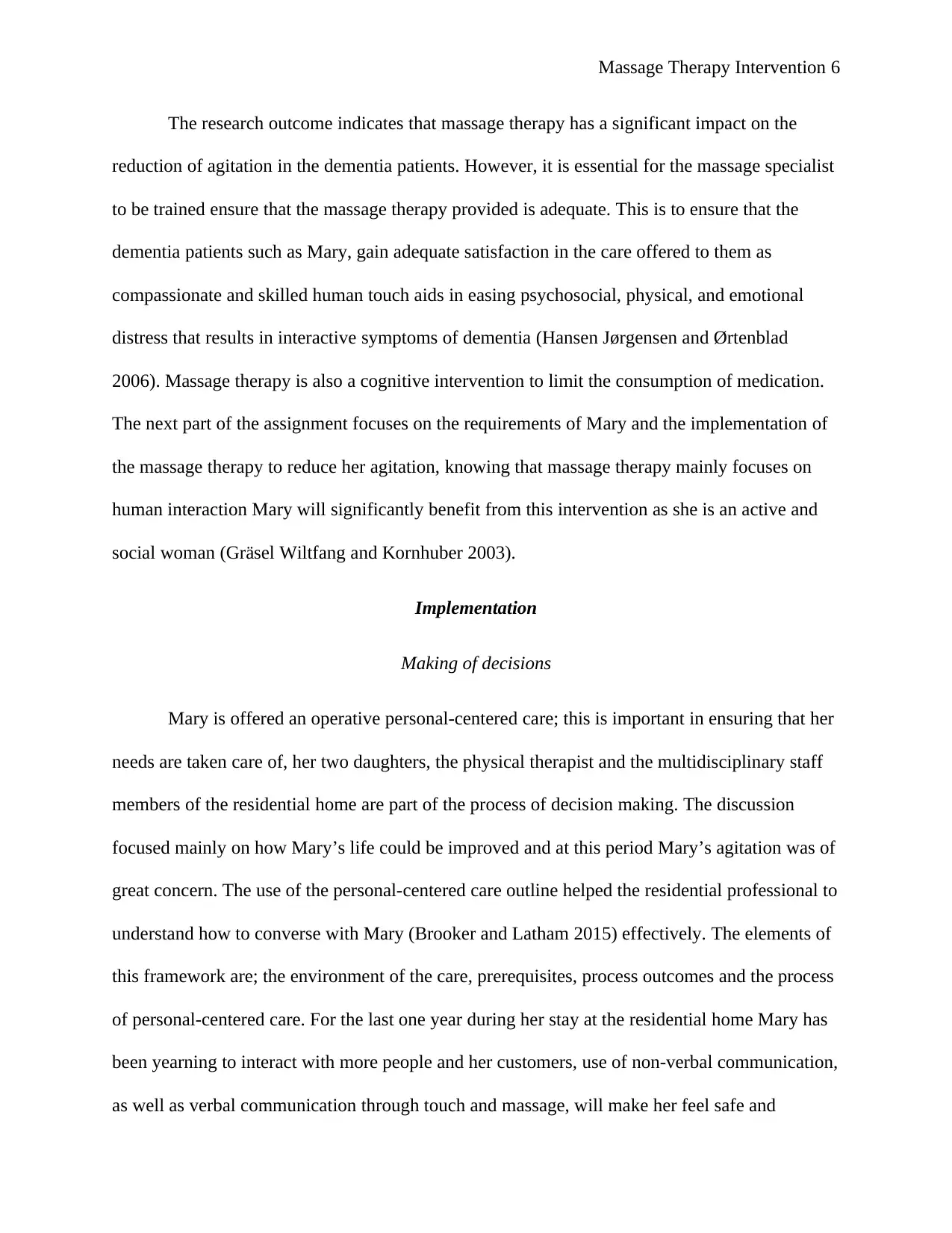
Massage Therapy Intervention 6
The research outcome indicates that massage therapy has a significant impact on the
reduction of agitation in the dementia patients. However, it is essential for the massage specialist
to be trained ensure that the massage therapy provided is adequate. This is to ensure that the
dementia patients such as Mary, gain adequate satisfaction in the care offered to them as
compassionate and skilled human touch aids in easing psychosocial, physical, and emotional
distress that results in interactive symptoms of dementia (Hansen Jørgensen and Ørtenblad
2006). Massage therapy is also a cognitive intervention to limit the consumption of medication.
The next part of the assignment focuses on the requirements of Mary and the implementation of
the massage therapy to reduce her agitation, knowing that massage therapy mainly focuses on
human interaction Mary will significantly benefit from this intervention as she is an active and
social woman (Gräsel Wiltfang and Kornhuber 2003).
Implementation
Making of decisions
Mary is offered an operative personal-centered care; this is important in ensuring that her
needs are taken care of, her two daughters, the physical therapist and the multidisciplinary staff
members of the residential home are part of the process of decision making. The discussion
focused mainly on how Mary’s life could be improved and at this period Mary’s agitation was of
great concern. The use of the personal-centered care outline helped the residential professional to
understand how to converse with Mary (Brooker and Latham 2015) effectively. The elements of
this framework are; the environment of the care, prerequisites, process outcomes and the process
of personal-centered care. For the last one year during her stay at the residential home Mary has
been yearning to interact with more people and her customers, use of non-verbal communication,
as well as verbal communication through touch and massage, will make her feel safe and
The research outcome indicates that massage therapy has a significant impact on the
reduction of agitation in the dementia patients. However, it is essential for the massage specialist
to be trained ensure that the massage therapy provided is adequate. This is to ensure that the
dementia patients such as Mary, gain adequate satisfaction in the care offered to them as
compassionate and skilled human touch aids in easing psychosocial, physical, and emotional
distress that results in interactive symptoms of dementia (Hansen Jørgensen and Ørtenblad
2006). Massage therapy is also a cognitive intervention to limit the consumption of medication.
The next part of the assignment focuses on the requirements of Mary and the implementation of
the massage therapy to reduce her agitation, knowing that massage therapy mainly focuses on
human interaction Mary will significantly benefit from this intervention as she is an active and
social woman (Gräsel Wiltfang and Kornhuber 2003).
Implementation
Making of decisions
Mary is offered an operative personal-centered care; this is important in ensuring that her
needs are taken care of, her two daughters, the physical therapist and the multidisciplinary staff
members of the residential home are part of the process of decision making. The discussion
focused mainly on how Mary’s life could be improved and at this period Mary’s agitation was of
great concern. The use of the personal-centered care outline helped the residential professional to
understand how to converse with Mary (Brooker and Latham 2015) effectively. The elements of
this framework are; the environment of the care, prerequisites, process outcomes and the process
of personal-centered care. For the last one year during her stay at the residential home Mary has
been yearning to interact with more people and her customers, use of non-verbal communication,
as well as verbal communication through touch and massage, will make her feel safe and
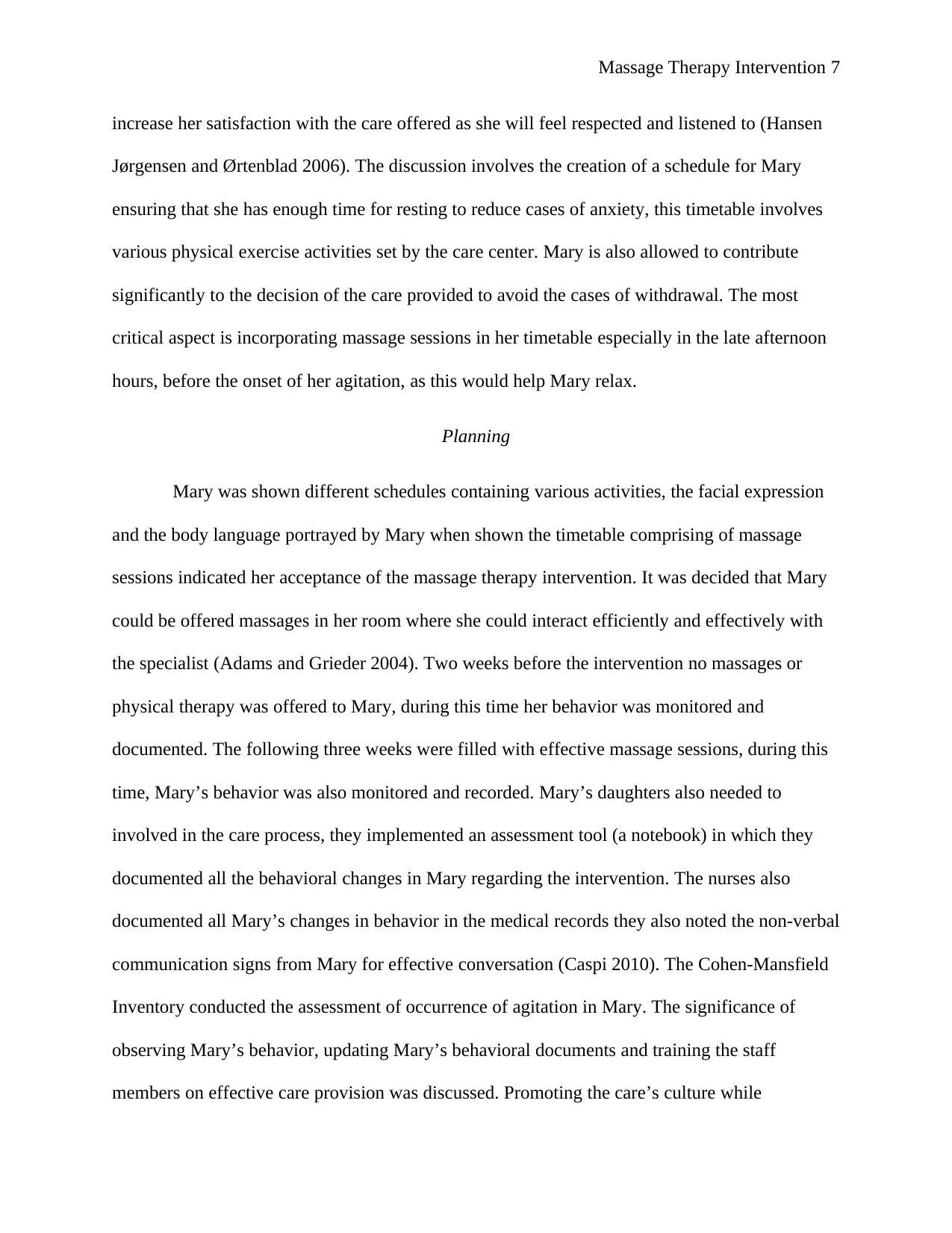
Massage Therapy Intervention 7
increase her satisfaction with the care offered as she will feel respected and listened to (Hansen
Jørgensen and Ørtenblad 2006). The discussion involves the creation of a schedule for Mary
ensuring that she has enough time for resting to reduce cases of anxiety, this timetable involves
various physical exercise activities set by the care center. Mary is also allowed to contribute
significantly to the decision of the care provided to avoid the cases of withdrawal. The most
critical aspect is incorporating massage sessions in her timetable especially in the late afternoon
hours, before the onset of her agitation, as this would help Mary relax.
Planning
Mary was shown different schedules containing various activities, the facial expression
and the body language portrayed by Mary when shown the timetable comprising of massage
sessions indicated her acceptance of the massage therapy intervention. It was decided that Mary
could be offered massages in her room where she could interact efficiently and effectively with
the specialist (Adams and Grieder 2004). Two weeks before the intervention no massages or
physical therapy was offered to Mary, during this time her behavior was monitored and
documented. The following three weeks were filled with effective massage sessions, during this
time, Mary’s behavior was also monitored and recorded. Mary’s daughters also needed to
involved in the care process, they implemented an assessment tool (a notebook) in which they
documented all the behavioral changes in Mary regarding the intervention. The nurses also
documented all Mary’s changes in behavior in the medical records they also noted the non-verbal
communication signs from Mary for effective conversation (Caspi 2010). The Cohen-Mansfield
Inventory conducted the assessment of occurrence of agitation in Mary. The significance of
observing Mary’s behavior, updating Mary’s behavioral documents and training the staff
members on effective care provision was discussed. Promoting the care’s culture while
increase her satisfaction with the care offered as she will feel respected and listened to (Hansen
Jørgensen and Ørtenblad 2006). The discussion involves the creation of a schedule for Mary
ensuring that she has enough time for resting to reduce cases of anxiety, this timetable involves
various physical exercise activities set by the care center. Mary is also allowed to contribute
significantly to the decision of the care provided to avoid the cases of withdrawal. The most
critical aspect is incorporating massage sessions in her timetable especially in the late afternoon
hours, before the onset of her agitation, as this would help Mary relax.
Planning
Mary was shown different schedules containing various activities, the facial expression
and the body language portrayed by Mary when shown the timetable comprising of massage
sessions indicated her acceptance of the massage therapy intervention. It was decided that Mary
could be offered massages in her room where she could interact efficiently and effectively with
the specialist (Adams and Grieder 2004). Two weeks before the intervention no massages or
physical therapy was offered to Mary, during this time her behavior was monitored and
documented. The following three weeks were filled with effective massage sessions, during this
time, Mary’s behavior was also monitored and recorded. Mary’s daughters also needed to
involved in the care process, they implemented an assessment tool (a notebook) in which they
documented all the behavioral changes in Mary regarding the intervention. The nurses also
documented all Mary’s changes in behavior in the medical records they also noted the non-verbal
communication signs from Mary for effective conversation (Caspi 2010). The Cohen-Mansfield
Inventory conducted the assessment of occurrence of agitation in Mary. The significance of
observing Mary’s behavior, updating Mary’s behavioral documents and training the staff
members on effective care provision was discussed. Promoting the care’s culture while
Paraphrase This Document
Need a fresh take? Get an instant paraphrase of this document with our AI Paraphraser
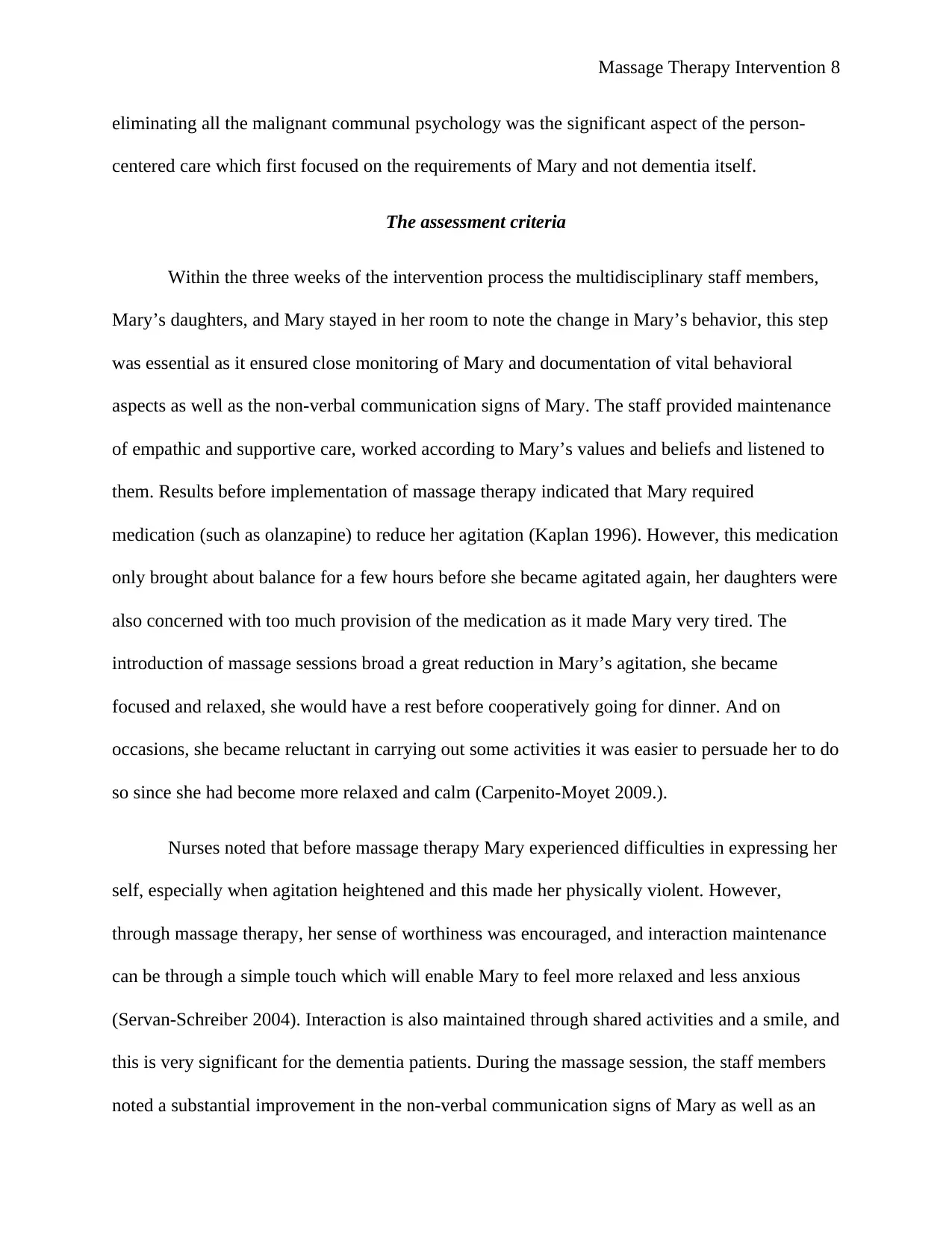
Massage Therapy Intervention 8
eliminating all the malignant communal psychology was the significant aspect of the person-
centered care which first focused on the requirements of Mary and not dementia itself.
The assessment criteria
Within the three weeks of the intervention process the multidisciplinary staff members,
Mary’s daughters, and Mary stayed in her room to note the change in Mary’s behavior, this step
was essential as it ensured close monitoring of Mary and documentation of vital behavioral
aspects as well as the non-verbal communication signs of Mary. The staff provided maintenance
of empathic and supportive care, worked according to Mary’s values and beliefs and listened to
them. Results before implementation of massage therapy indicated that Mary required
medication (such as olanzapine) to reduce her agitation (Kaplan 1996). However, this medication
only brought about balance for a few hours before she became agitated again, her daughters were
also concerned with too much provision of the medication as it made Mary very tired. The
introduction of massage sessions broad a great reduction in Mary’s agitation, she became
focused and relaxed, she would have a rest before cooperatively going for dinner. And on
occasions, she became reluctant in carrying out some activities it was easier to persuade her to do
so since she had become more relaxed and calm (Carpenito-Moyet 2009.).
Nurses noted that before massage therapy Mary experienced difficulties in expressing her
self, especially when agitation heightened and this made her physically violent. However,
through massage therapy, her sense of worthiness was encouraged, and interaction maintenance
can be through a simple touch which will enable Mary to feel more relaxed and less anxious
(Servan-Schreiber 2004). Interaction is also maintained through shared activities and a smile, and
this is very significant for the dementia patients. During the massage session, the staff members
noted a substantial improvement in the non-verbal communication signs of Mary as well as an
eliminating all the malignant communal psychology was the significant aspect of the person-
centered care which first focused on the requirements of Mary and not dementia itself.
The assessment criteria
Within the three weeks of the intervention process the multidisciplinary staff members,
Mary’s daughters, and Mary stayed in her room to note the change in Mary’s behavior, this step
was essential as it ensured close monitoring of Mary and documentation of vital behavioral
aspects as well as the non-verbal communication signs of Mary. The staff provided maintenance
of empathic and supportive care, worked according to Mary’s values and beliefs and listened to
them. Results before implementation of massage therapy indicated that Mary required
medication (such as olanzapine) to reduce her agitation (Kaplan 1996). However, this medication
only brought about balance for a few hours before she became agitated again, her daughters were
also concerned with too much provision of the medication as it made Mary very tired. The
introduction of massage sessions broad a great reduction in Mary’s agitation, she became
focused and relaxed, she would have a rest before cooperatively going for dinner. And on
occasions, she became reluctant in carrying out some activities it was easier to persuade her to do
so since she had become more relaxed and calm (Carpenito-Moyet 2009.).
Nurses noted that before massage therapy Mary experienced difficulties in expressing her
self, especially when agitation heightened and this made her physically violent. However,
through massage therapy, her sense of worthiness was encouraged, and interaction maintenance
can be through a simple touch which will enable Mary to feel more relaxed and less anxious
(Servan-Schreiber 2004). Interaction is also maintained through shared activities and a smile, and
this is very significant for the dementia patients. During the massage session, the staff members
noted a substantial improvement in the non-verbal communication signs of Mary as well as an
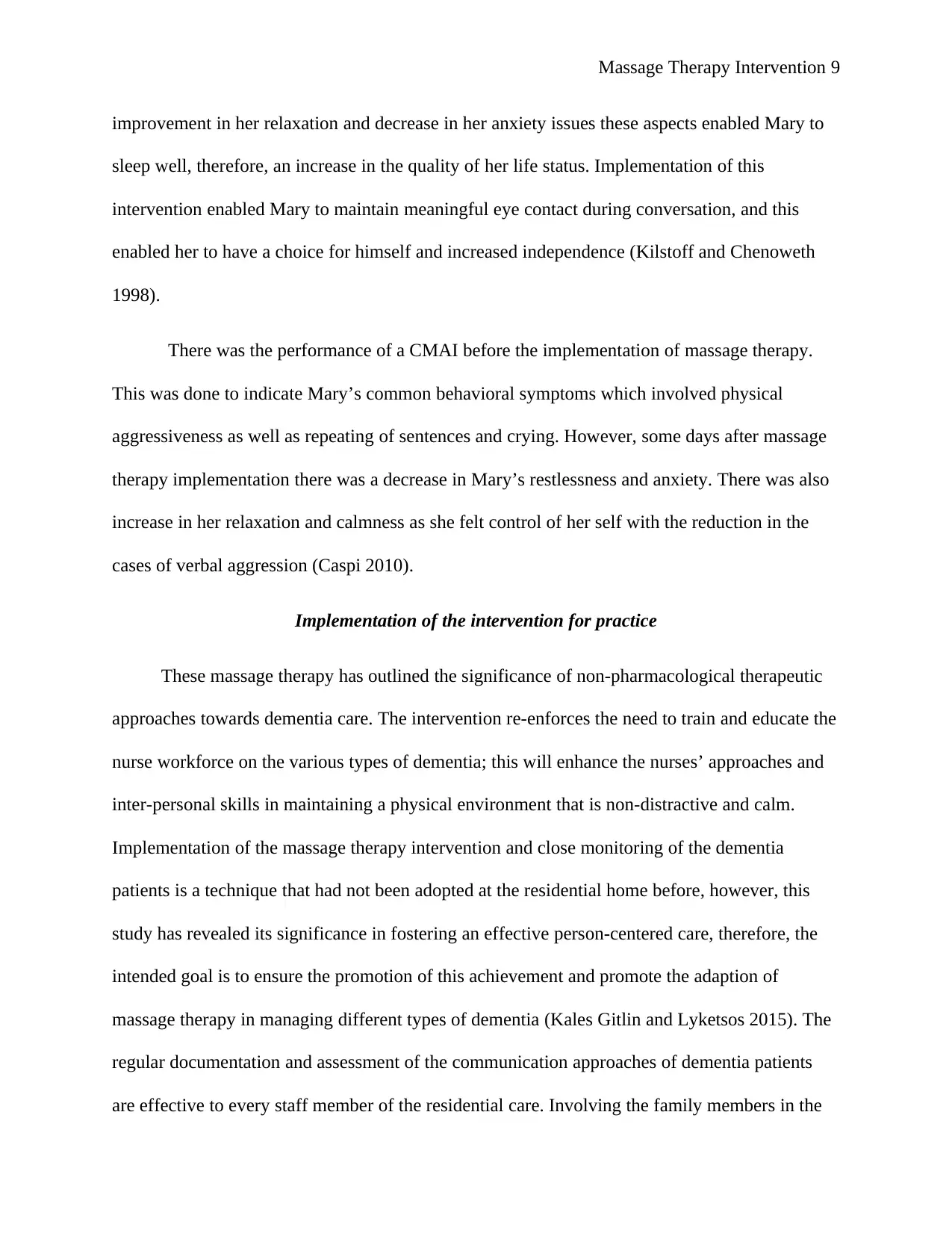
Massage Therapy Intervention 9
improvement in her relaxation and decrease in her anxiety issues these aspects enabled Mary to
sleep well, therefore, an increase in the quality of her life status. Implementation of this
intervention enabled Mary to maintain meaningful eye contact during conversation, and this
enabled her to have a choice for himself and increased independence (Kilstoff and Chenoweth
1998).
There was the performance of a CMAI before the implementation of massage therapy.
This was done to indicate Mary’s common behavioral symptoms which involved physical
aggressiveness as well as repeating of sentences and crying. However, some days after massage
therapy implementation there was a decrease in Mary’s restlessness and anxiety. There was also
increase in her relaxation and calmness as she felt control of her self with the reduction in the
cases of verbal aggression (Caspi 2010).
Implementation of the intervention for practice
These massage therapy has outlined the significance of non-pharmacological therapeutic
approaches towards dementia care. The intervention re-enforces the need to train and educate the
nurse workforce on the various types of dementia; this will enhance the nurses’ approaches and
inter-personal skills in maintaining a physical environment that is non-distractive and calm.
Implementation of the massage therapy intervention and close monitoring of the dementia
patients is a technique that had not been adopted at the residential home before, however, this
study has revealed its significance in fostering an effective person-centered care, therefore, the
intended goal is to ensure the promotion of this achievement and promote the adaption of
massage therapy in managing different types of dementia (Kales Gitlin and Lyketsos 2015). The
regular documentation and assessment of the communication approaches of dementia patients
are effective to every staff member of the residential care. Involving the family members in the
improvement in her relaxation and decrease in her anxiety issues these aspects enabled Mary to
sleep well, therefore, an increase in the quality of her life status. Implementation of this
intervention enabled Mary to maintain meaningful eye contact during conversation, and this
enabled her to have a choice for himself and increased independence (Kilstoff and Chenoweth
1998).
There was the performance of a CMAI before the implementation of massage therapy.
This was done to indicate Mary’s common behavioral symptoms which involved physical
aggressiveness as well as repeating of sentences and crying. However, some days after massage
therapy implementation there was a decrease in Mary’s restlessness and anxiety. There was also
increase in her relaxation and calmness as she felt control of her self with the reduction in the
cases of verbal aggression (Caspi 2010).
Implementation of the intervention for practice
These massage therapy has outlined the significance of non-pharmacological therapeutic
approaches towards dementia care. The intervention re-enforces the need to train and educate the
nurse workforce on the various types of dementia; this will enhance the nurses’ approaches and
inter-personal skills in maintaining a physical environment that is non-distractive and calm.
Implementation of the massage therapy intervention and close monitoring of the dementia
patients is a technique that had not been adopted at the residential home before, however, this
study has revealed its significance in fostering an effective person-centered care, therefore, the
intended goal is to ensure the promotion of this achievement and promote the adaption of
massage therapy in managing different types of dementia (Kales Gitlin and Lyketsos 2015). The
regular documentation and assessment of the communication approaches of dementia patients
are effective to every staff member of the residential care. Involving the family members in the
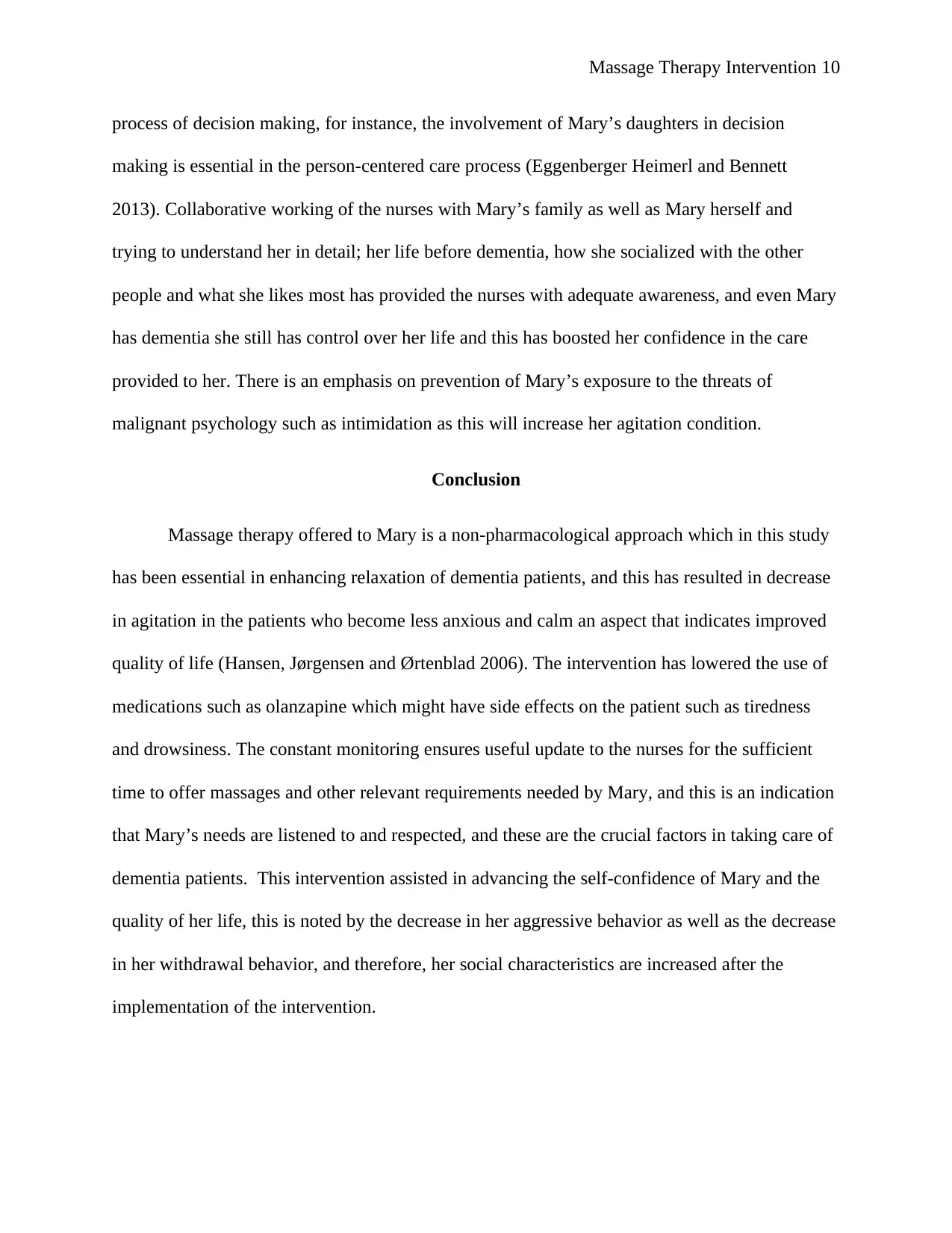
Massage Therapy Intervention 10
process of decision making, for instance, the involvement of Mary’s daughters in decision
making is essential in the person-centered care process (Eggenberger Heimerl and Bennett
2013). Collaborative working of the nurses with Mary’s family as well as Mary herself and
trying to understand her in detail; her life before dementia, how she socialized with the other
people and what she likes most has provided the nurses with adequate awareness, and even Mary
has dementia she still has control over her life and this has boosted her confidence in the care
provided to her. There is an emphasis on prevention of Mary’s exposure to the threats of
malignant psychology such as intimidation as this will increase her agitation condition.
Conclusion
Massage therapy offered to Mary is a non-pharmacological approach which in this study
has been essential in enhancing relaxation of dementia patients, and this has resulted in decrease
in agitation in the patients who become less anxious and calm an aspect that indicates improved
quality of life (Hansen, Jørgensen and Ørtenblad 2006). The intervention has lowered the use of
medications such as olanzapine which might have side effects on the patient such as tiredness
and drowsiness. The constant monitoring ensures useful update to the nurses for the sufficient
time to offer massages and other relevant requirements needed by Mary, and this is an indication
that Mary’s needs are listened to and respected, and these are the crucial factors in taking care of
dementia patients. This intervention assisted in advancing the self-confidence of Mary and the
quality of her life, this is noted by the decrease in her aggressive behavior as well as the decrease
in her withdrawal behavior, and therefore, her social characteristics are increased after the
implementation of the intervention.
process of decision making, for instance, the involvement of Mary’s daughters in decision
making is essential in the person-centered care process (Eggenberger Heimerl and Bennett
2013). Collaborative working of the nurses with Mary’s family as well as Mary herself and
trying to understand her in detail; her life before dementia, how she socialized with the other
people and what she likes most has provided the nurses with adequate awareness, and even Mary
has dementia she still has control over her life and this has boosted her confidence in the care
provided to her. There is an emphasis on prevention of Mary’s exposure to the threats of
malignant psychology such as intimidation as this will increase her agitation condition.
Conclusion
Massage therapy offered to Mary is a non-pharmacological approach which in this study
has been essential in enhancing relaxation of dementia patients, and this has resulted in decrease
in agitation in the patients who become less anxious and calm an aspect that indicates improved
quality of life (Hansen, Jørgensen and Ørtenblad 2006). The intervention has lowered the use of
medications such as olanzapine which might have side effects on the patient such as tiredness
and drowsiness. The constant monitoring ensures useful update to the nurses for the sufficient
time to offer massages and other relevant requirements needed by Mary, and this is an indication
that Mary’s needs are listened to and respected, and these are the crucial factors in taking care of
dementia patients. This intervention assisted in advancing the self-confidence of Mary and the
quality of her life, this is noted by the decrease in her aggressive behavior as well as the decrease
in her withdrawal behavior, and therefore, her social characteristics are increased after the
implementation of the intervention.
Secure Best Marks with AI Grader
Need help grading? Try our AI Grader for instant feedback on your assignments.

Massage Therapy Intervention 11
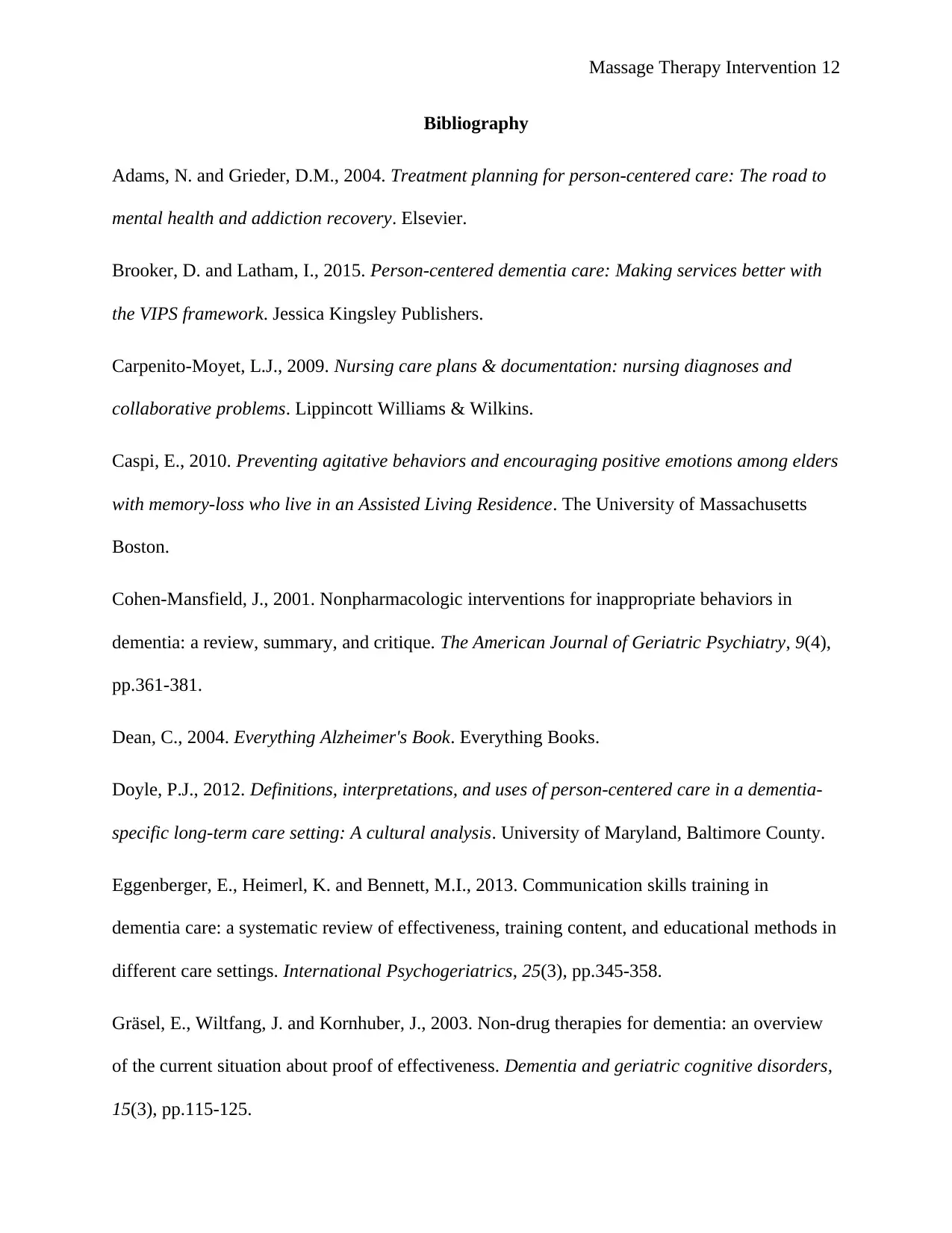
Massage Therapy Intervention 12
Bibliography
Adams, N. and Grieder, D.M., 2004. Treatment planning for person-centered care: The road to
mental health and addiction recovery. Elsevier.
Brooker, D. and Latham, I., 2015. Person-centered dementia care: Making services better with
the VIPS framework. Jessica Kingsley Publishers.
Carpenito-Moyet, L.J., 2009. Nursing care plans & documentation: nursing diagnoses and
collaborative problems. Lippincott Williams & Wilkins.
Caspi, E., 2010. Preventing agitative behaviors and encouraging positive emotions among elders
with memory-loss who live in an Assisted Living Residence. The University of Massachusetts
Boston.
Cohen-Mansfield, J., 2001. Nonpharmacologic interventions for inappropriate behaviors in
dementia: a review, summary, and critique. The American Journal of Geriatric Psychiatry, 9(4),
pp.361-381.
Dean, C., 2004. Everything Alzheimer's Book. Everything Books.
Doyle, P.J., 2012. Definitions, interpretations, and uses of person-centered care in a dementia-
specific long-term care setting: A cultural analysis. University of Maryland, Baltimore County.
Eggenberger, E., Heimerl, K. and Bennett, M.I., 2013. Communication skills training in
dementia care: a systematic review of effectiveness, training content, and educational methods in
different care settings. International Psychogeriatrics, 25(3), pp.345-358.
Gräsel, E., Wiltfang, J. and Kornhuber, J., 2003. Non-drug therapies for dementia: an overview
of the current situation about proof of effectiveness. Dementia and geriatric cognitive disorders,
15(3), pp.115-125.
Bibliography
Adams, N. and Grieder, D.M., 2004. Treatment planning for person-centered care: The road to
mental health and addiction recovery. Elsevier.
Brooker, D. and Latham, I., 2015. Person-centered dementia care: Making services better with
the VIPS framework. Jessica Kingsley Publishers.
Carpenito-Moyet, L.J., 2009. Nursing care plans & documentation: nursing diagnoses and
collaborative problems. Lippincott Williams & Wilkins.
Caspi, E., 2010. Preventing agitative behaviors and encouraging positive emotions among elders
with memory-loss who live in an Assisted Living Residence. The University of Massachusetts
Boston.
Cohen-Mansfield, J., 2001. Nonpharmacologic interventions for inappropriate behaviors in
dementia: a review, summary, and critique. The American Journal of Geriatric Psychiatry, 9(4),
pp.361-381.
Dean, C., 2004. Everything Alzheimer's Book. Everything Books.
Doyle, P.J., 2012. Definitions, interpretations, and uses of person-centered care in a dementia-
specific long-term care setting: A cultural analysis. University of Maryland, Baltimore County.
Eggenberger, E., Heimerl, K. and Bennett, M.I., 2013. Communication skills training in
dementia care: a systematic review of effectiveness, training content, and educational methods in
different care settings. International Psychogeriatrics, 25(3), pp.345-358.
Gräsel, E., Wiltfang, J. and Kornhuber, J., 2003. Non-drug therapies for dementia: an overview
of the current situation about proof of effectiveness. Dementia and geriatric cognitive disorders,
15(3), pp.115-125.
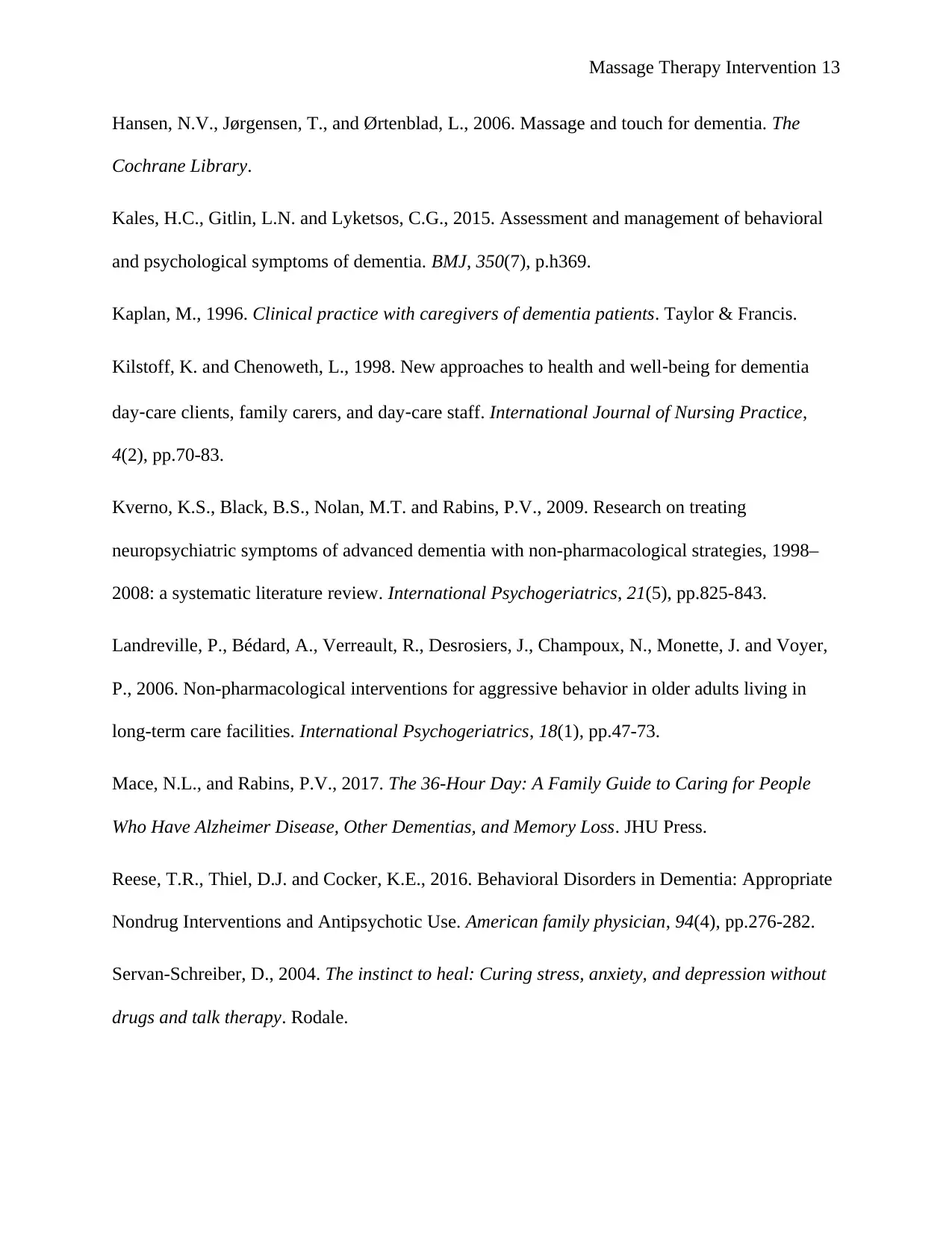
Massage Therapy Intervention 13
Hansen, N.V., Jørgensen, T., and Ørtenblad, L., 2006. Massage and touch for dementia. The
Cochrane Library.
Kales, H.C., Gitlin, L.N. and Lyketsos, C.G., 2015. Assessment and management of behavioral
and psychological symptoms of dementia. BMJ, 350(7), p.h369.
Kaplan, M., 1996. Clinical practice with caregivers of dementia patients. Taylor & Francis.
Kilstoff, K. and Chenoweth, L., 1998. New approaches to health and well‐being for dementia
day‐care clients, family carers, and day‐care staff. International Journal of Nursing Practice,
4(2), pp.70-83.
Kverno, K.S., Black, B.S., Nolan, M.T. and Rabins, P.V., 2009. Research on treating
neuropsychiatric symptoms of advanced dementia with non-pharmacological strategies, 1998–
2008: a systematic literature review. International Psychogeriatrics, 21(5), pp.825-843.
Landreville, P., Bédard, A., Verreault, R., Desrosiers, J., Champoux, N., Monette, J. and Voyer,
P., 2006. Non-pharmacological interventions for aggressive behavior in older adults living in
long-term care facilities. International Psychogeriatrics, 18(1), pp.47-73.
Mace, N.L., and Rabins, P.V., 2017. The 36-Hour Day: A Family Guide to Caring for People
Who Have Alzheimer Disease, Other Dementias, and Memory Loss. JHU Press.
Reese, T.R., Thiel, D.J. and Cocker, K.E., 2016. Behavioral Disorders in Dementia: Appropriate
Nondrug Interventions and Antipsychotic Use. American family physician, 94(4), pp.276-282.
Servan-Schreiber, D., 2004. The instinct to heal: Curing stress, anxiety, and depression without
drugs and talk therapy. Rodale.
Hansen, N.V., Jørgensen, T., and Ørtenblad, L., 2006. Massage and touch for dementia. The
Cochrane Library.
Kales, H.C., Gitlin, L.N. and Lyketsos, C.G., 2015. Assessment and management of behavioral
and psychological symptoms of dementia. BMJ, 350(7), p.h369.
Kaplan, M., 1996. Clinical practice with caregivers of dementia patients. Taylor & Francis.
Kilstoff, K. and Chenoweth, L., 1998. New approaches to health and well‐being for dementia
day‐care clients, family carers, and day‐care staff. International Journal of Nursing Practice,
4(2), pp.70-83.
Kverno, K.S., Black, B.S., Nolan, M.T. and Rabins, P.V., 2009. Research on treating
neuropsychiatric symptoms of advanced dementia with non-pharmacological strategies, 1998–
2008: a systematic literature review. International Psychogeriatrics, 21(5), pp.825-843.
Landreville, P., Bédard, A., Verreault, R., Desrosiers, J., Champoux, N., Monette, J. and Voyer,
P., 2006. Non-pharmacological interventions for aggressive behavior in older adults living in
long-term care facilities. International Psychogeriatrics, 18(1), pp.47-73.
Mace, N.L., and Rabins, P.V., 2017. The 36-Hour Day: A Family Guide to Caring for People
Who Have Alzheimer Disease, Other Dementias, and Memory Loss. JHU Press.
Reese, T.R., Thiel, D.J. and Cocker, K.E., 2016. Behavioral Disorders in Dementia: Appropriate
Nondrug Interventions and Antipsychotic Use. American family physician, 94(4), pp.276-282.
Servan-Schreiber, D., 2004. The instinct to heal: Curing stress, anxiety, and depression without
drugs and talk therapy. Rodale.
Paraphrase This Document
Need a fresh take? Get an instant paraphrase of this document with our AI Paraphraser
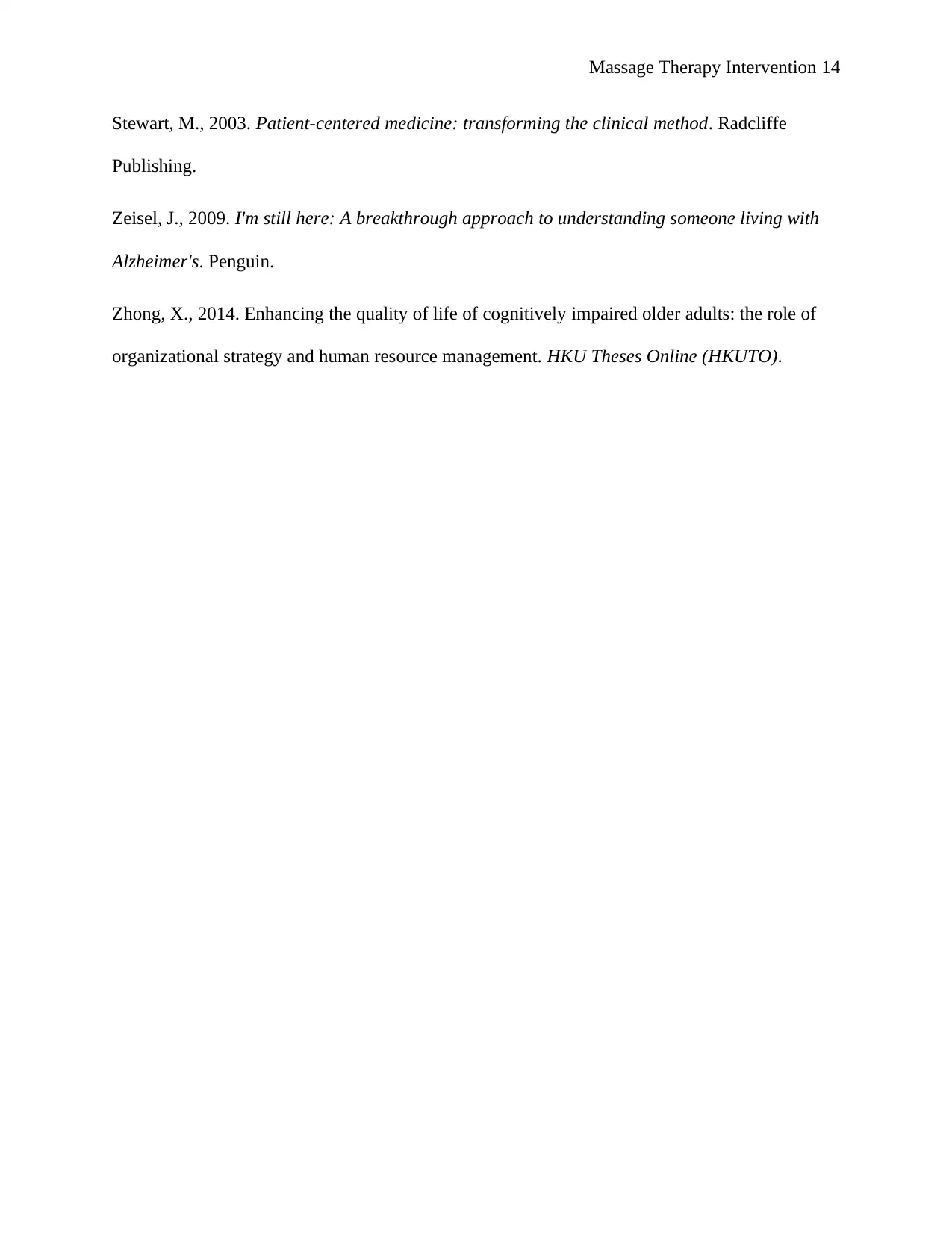
Massage Therapy Intervention 14
Stewart, M., 2003. Patient-centered medicine: transforming the clinical method. Radcliffe
Publishing.
Zeisel, J., 2009. I'm still here: A breakthrough approach to understanding someone living with
Alzheimer's. Penguin.
Zhong, X., 2014. Enhancing the quality of life of cognitively impaired older adults: the role of
organizational strategy and human resource management. HKU Theses Online (HKUTO).
Stewart, M., 2003. Patient-centered medicine: transforming the clinical method. Radcliffe
Publishing.
Zeisel, J., 2009. I'm still here: A breakthrough approach to understanding someone living with
Alzheimer's. Penguin.
Zhong, X., 2014. Enhancing the quality of life of cognitively impaired older adults: the role of
organizational strategy and human resource management. HKU Theses Online (HKUTO).
1 out of 14
Related Documents
Your All-in-One AI-Powered Toolkit for Academic Success.
+13062052269
info@desklib.com
Available 24*7 on WhatsApp / Email
![[object Object]](/_next/static/media/star-bottom.7253800d.svg)
Unlock your academic potential
© 2024 | Zucol Services PVT LTD | All rights reserved.



